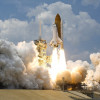That the Earth's Moon owes its origins to a cosmic collision four-and-a-half billion years ago seems increasingly likely, according to new research announced this week.
 Prior to the Apollo missions of the 1970s, which retrieved samples from the lunar surface for analysis, the prevailing theory of the Moon's origins was that material had somehow "spun off" the early Earth and coalesced in orbit.
Prior to the Apollo missions of the 1970s, which retrieved samples from the lunar surface for analysis, the prevailing theory of the Moon's origins was that material had somehow "spun off" the early Earth and coalesced in orbit.
But analysis of lunar rocks shows that the composition differs subtley from the Earth's crust material, ruling out Earth as the sole origin.
This spawned a theory known colloquially as "the big splat", which advanced the idea that, early in its history, the Earth collided with a smaller world, known as Theia, ejecting a mixture of the surface crust from the two bodies into orbit around the planet.
科学家推测,这种材料是什么形式ed the Moon. But, if this were the case, the material the Moon is made from should differ chemically from the composition of the Earth, but it doesn't.
Now, three papers in the journalNature, by German, Israeli, French and US scientists, have conducted simulations of the early solar system and also made highly precise and accurate measurements of the levels of different chemical forms known as isotopes to probe the origin and birthdate of the Moon in more detail.
Together, these data lend support for a lunar collision theory.
One of the papers looks at the relative abundances of three isotopes of oxygen, which can be used as a chemical fingerprint.
Structures formed in the same regions of the solar system have similar isotope profiles, and by comparing the material on the Earth and Moon, this is what they see, suggesting that the impactor that collided with the Earth to form the Moon came from our cosmic neighbourhood, rather than farther out in the solar system.
The second paper, by running simulations of the formation of the early solar system, considers the likelihood of the existence of a collision with an impactor on the scale of the notional Theia. The simulations suggest odds of about 20% of this happening, which is small but reasonable.
The third paper looks at a different question, which is what happened to the Moon and Earth subsequently.
According to prevailing theories of the solar system's evolution, both Earth and the Moon should have collected, after their formation, a veneer of material accrued through collisions with cosmic impactors. And because the Earth is larger, it should have picked up more of this material than the Moon, widening the gap in the chemical makeups of the two.
这是what researchers have now measured, picking up as they have tiny differences in the levels of the element tungsten between Moon and Earth rocks.
Together, the results show that it's plausible for a Mars-sized object to have formed in a similar region of space and subsequently collided and merged with the young Earth.
Debris ejected by the smash accreted into the Moon, and then both bodies were decorated by material raining down on them later from space.
References
- Previous更好的基因工具箱
- NextPlucking triggers hair regrowth









Comments
Add a comment